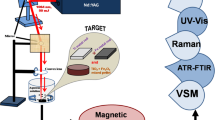Abstract
Titanium dioxide ultrafine particles (UFPs) are produced by pulsed laser ablation of titanium or titanium dioxide (anatase and rutile) rods in an atmosphere of He or O2/He mixture. The collected UFPs on cellulose membrane filters at the exit of the ablation chamber are analyzed by X-ray diffraction (XRD) and transmission electron microscopy (TEM). The TiO2 particles produced are composed of very small particles (diameter: 10–50 nm) that are completely anatase, irrespective of the rod material, and relatively large particles (diameter: 100 nm–1 μm) that are a mixture of anatase and rutile. The large particles consist of the direct strip-off fragments coming from the rod surface. The particles obtained from the laser ablation on TiO2 rods in an atmosphere of He contains gray particles that are supposed to be amorphous TiO2 (x < 2). In the presence of O2 in the ablation chamber, these oxygen defects in amorphous TiO2 are stabilized and anatase UFPs are formed. These results suggest that the crystal phase of the products can be controlled by adjusting the rod material and the gases used in the ablation process.
Similar content being viewed by others
References
Anpo M., T. Shima, S. Komada & Y. Kubokawa, 1987. Photocatalytic hydrogenation of CH3CCH with H2O on small particle TiO2: Size quantization effects and reaction intermediates. J. Phys. Chem. 91, 4305–4310.
Barnes N.R., R. Dat, D.J. Lichtenwalner, A.F. Schreiner, O. Auciello & O.E.Hankins, 1995. Multiband analysis of photoluminescence spectra from electronically excited gas-phase species produced during laser ablation of lead oxide, zirconium oxide, titanium oxide and lead zirconate titanate targets. Chem. Mater. 7, 477–485.
Barringer E.A. & H.K. Bowen, 1982. Formation, packing, and sintering of monodisperse TiO2 powders. J. Am. Ceram. Soc. 65, C199.
Charpin J., A.J. Burggraafand & L. Cot, 1991. Asurvey of ceramic membranes for separations in liquid and gaseous media. Ind. Ceram. 11, 83–90.
Fujishima A. & K. Honda, 1972. Electrochemical photolysis of water at a semi-conductor electrode. Nature 238, 37–38.
Grabner G., G. Li, R.M. Quint, R. Quint & N. Getoff, 1991. Pulsed laser-induced oxidation of phenol in acid aqueous TiO2. J. Chem. Soc. Faraday Trans. 87, 1097–1101.
Grigoriu C., M. Hirai, K. Nishiura, W. Jiang & K. Yatsui, 2000. Synthesis of nanosized aluminum nitride powders by pulsed laser ablation. J. Am. Ceram. Soc. 83, 2631–2633.
Ichihashi T., M. Kato & N. Wada, 1981. Quenched high pressure phase of MnF2 in the gas-evaporated fine particles. J. Phys. Soc. Jpn. 50, 3539–3540.
Iida Y. & S. Ozaki, 1961. Grain growth and phase transformation of titanium oxide during calcination. J. Am. Ceram. Soc. 44, 120–127.
Juang C.B., H. Cai, M.F. Becker, J.W. Keto & J.R. Brock, 1994. Synthesis of nanometer glass particles by pulsed-laser ablation of microspheres. Appl. Phys. Lett. 65, 40–42.
Kormann C., D.W. Bahnemann & M.R. Hofmann, 1988. Preparation and characterization of quantum-size titanium dioxide. J. Phys. Chem. 92, 5196–5201.
Kumer K.N.P., K. Keizer, A.J. Burggraaf, T. Okubo, H. Nagamoto & S. Morooka, 1992. Densification of nanostructured titania assisted by a phase transformation. Nature 358, 48–51.
Larbot A., J.P. Fabre, C. Guizard & L. Cot, 1989. New inorganic ultrafiltration membranes: Titania and zirconia membranes. J. Am. Ceram. Soc. 72, 257–261.
Lillich H., L.E. Aleandri, D.J. Jones, J. Rozière, P. Albers, K. Seibold, A. Freund, V. Zumbach & J. Wolfrum, 1995. Production and characterization of noble metal clusters by laser ablation. J. Phys. Chem. 99, 12413–12421.
Shannon R.D., 1964. Phase transformations studies in TiO2 supporting different defect mechanisms in vacuum-reduced and hydrogen-reduced rutile. J. App1. Phys. 35, 3414–3416.
Shannon R.D. & J.A. Pask, 1965. Kinetics of the anatase-rutile transformation. J. Am. Ceram. Soc. 48, 391–398.
Uhlhorn R.J.R., M.H.B.J. Huis in't Veld, K. Keizer & A.J. Burggraaf, 1992. J Synthesis of ceramic membranes. Part I. Synthesis of non-supported and supported γ-alumina membranes without defacts. Mater. Sci. 27, 527–537.
Yatsui K., T. Yukawa, C. Grigoriu, M Hirai & W. Jiang, 2000. Synthesis of ultrafine γ-Al2O3powders by pulsed laser ablation. J. Nanoparticle Res. 2, 75–83.
Zaspalis V.T., W. Van Praag, K. Keizer, J.R.H. Ross & A.J. Burggraaf, 1992. Synthesis and characterization of primary alumina, titania and binary membranes. J. Mater. Sci. 27, 1023–1035.
Author information
Authors and Affiliations
Rights and permissions
About this article
Cite this article
Harano, A., Shimada, K., Okubo, T. et al. Crystal Phases of TiO2 Ultrafine Particles Prepared by Laser Ablation of Solid Rods. Journal of Nanoparticle Research 4, 215–219 (2002). https://doi.org/10.1023/A:1019935427050
Issue Date:
DOI: https://doi.org/10.1023/A:1019935427050




